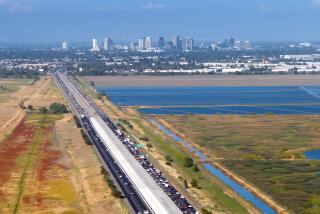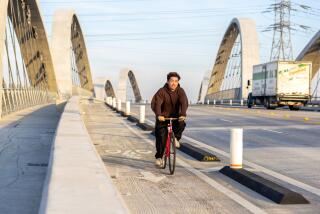Squeaky Wheels
Out of the billions of federal gasoline tax dollars spent annually on transportation improvements, less than 1% goes toward bicycle projects, such as trails, designated lanes and parking facilities at mass transportation hubs. But that less than 1% has become a focal point in a national debate over how much of the gas money should fund projects that don’t build, repair or expand highways.
“Bike lanes are the kind of nicety we can’t afford when we look at the condition of our roads and bridges in this country,” said William Fay, president of the American Highway Users Alliance, a Washington, D.C.-based interest group funded by auto manufacturers, the petroleum industry, insurance companies and a truck drivers organization.
“Bike lanes are not a luxury,” countered Beth Kirsch, head of Bikes Belong, a coalition of bicycle manufacturers and riders, also based in Washington. “Four million people in this country commute to work on a bicycle. What about their safety and the fact that they help cut down on pollution, automobile traffic, and wear and tear on roads?”
It’s not a new debate, but it has taken on crucial importance this year because the Intermodal Surface Transportation Efficiency Act, which declares how states are to spend federal gas tax revenue, is up for renewal.
ISTEA, which everyone in the transportation field pronounces “iced tea,” first went into effect in 1992. It significantly changed federal gas tax funding, which since the mid-1950s had gone almost exclusively toward building the national interstate highway system.
This act mandated that 20% of grants derived from the tax (currently 18.3 cents per gallon, although 4.3 cents of that goes directly toward easing the national debt) had to go toward non-highway building or repair projects, such as mass transportation, anti-pollution programs, pedestrian walkways and bicycle paths.
The mandate proved a boon to bicyclists.
“From 1973 to 1991, when spending the federal funds on non-highway projects was optional, $40 million of federal transportation dollars went to bike projects,” Kirsch said. “Since ISTEA went into effect, more than $1 billion has been spent.”
Fay isn’t against mandates, but he wants them to go the other way.
“We would like to see 85% of the tax funds dedicated to the national highway system,” he said. “The other 15% could be used to streamline transportation.”
That 15% would be optional. Under the American Highway Users Alliance proposal, a state could use 100% of federal grants on highways.
Kirsch counters that this would result in a major cutback in bike projects. “If you take a look at the history of this funding, you can see that if it’s optional, it’s not going to get done,” she said.
The biggest local bicycle project funded by ISTEA is the Long Beach Bikestation, which includes guarded bike parking areas, a bike rental service and a shop. It’s located near two Metro Rail Blue Line stations to encourage commuting.
About $230,000 in ISTEA funds was used to build and initially operate the station, which now provides parking for an average of 35 bicycles a day, although in some months the average daily use is as high as 60, according to a Long Beach city spokeswoman.
In Los Angeles, the city is planning to use ISTEA funds for a two-mile extension of the Culver Bikeway, which now exists only within Culver City, into Los Angeles. The extension, running down a median strip, is scheduled to open by the end of the year and cost about $1.5 million.
Another trail, now in the design stage, will run alongside Exposition Boulevard from Vermont Avenue to La Brea Avenue. Its projected cost is $2 million, all to come from ISTEA funds.
Although Fay has little good to say about bicycles--”I see them on my way to work, and they do slow down traffic”--he said he does not object to the construction of bike trails, as long as the funds are not diverted from those he believes should go to highways.
“We are falling way short of meeting our needs for highways and bridges,” he said. “We need to invest $20 billion more each year just to keep them in their current condition.”
He stresses that because roads are not being properly maintained, they are becoming unsafe. “We are talking about saving lives,” Fay said.
Fay and Kirsch had obviously raked over each other’s arguments many times. Asked about highway safety issues, Kirsch had a quick answer.
“According to statistics, 15% of accidents involve pedestrians or bicycles,” she said. “But only a total of 1% of funds go to pedestrian and bike safety projects.
“They say, ‘Spend money on safe roads.’ We say, ‘We should also provide safe places for pedestrians and bikes.’ ”
Another statistic in Kirsch’s arsenal is a poll funded by Bikes Belong showing that 64% of voters nationally favor using 1% of gas tax money “for things like bicycle trails, bike lanes and sidewalks.”
But Fay had an answer for that. “If you just ask someone if they are in favor of using 1%, that doesn’t sound like much. But we need those funds now to fix our highways.”
The current ISTEA expires Sept. 30. Committees in the House and Senate have held hearings on the renewal issue.
More to Read
Sign up for Essential California
The most important California stories and recommendations in your inbox every morning.
You may occasionally receive promotional content from the Los Angeles Times.











